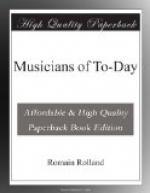[Footnote 255: “In this,” says M. Buchor, “as in many other things, the children of the people set an example to the children of the middle classes.” That is true; but one must not blame the middle-class children so much as those in authority, who, “in this, as in many other things,” have not fulfilled their duties.]
[Footnote 256: The Passion according to St. Matthew was given first of all by two little choirs, consisting of from twelve to sixteen students, including the soloists.]
Let us hope on and persevere. The main thing is that a start has been made; the thing that remains is to have patience and—persistence.
THE PRESENT CONDITION OF FRENCH MUSIC
We have seen how the musical education of France is going on in theatres, in concerts, in schools, by lectures and by books; and the Parisian’s rather restless desire for knowledge seems to be satisfied for the moment. The mind of Paris has made a journey—a hasty journey, it is true through the music of other countries and other times,[257] and is now becoming introspective. After a mad enthusiasm over discoveries in strange lands, music and musical criticism have regained their self-possession and their jealous love of independence. A very decided reaction against foreign music has been shown since the time of the Universal Exhibition of 1900. This movement is not unconnected, consciously or unconsciously, with the nationalist train of thought, which was stirred up in France, and especially in Paris, somewhere about the same time. But it is also a natural development in the evolution of music. French music felt new vigour springing up within her, and was astonished at it; her days of preparation were over, and she aspired to fly alone; and, in accordance with the eternal rule of history, the first use she made of her newly-acquired strength was to defy her teachers. And this revolt against foreign influences was directed—one had expected it—against the strongest of the influences—the influence of German music as personified by Wagner. Two discussions in magazines, in 1903 and 1904, brought this state of mind curiously to light: one was an enquiry held by M. Jacques Morland in the Mercure de France (January, 1903) as to The Influence of German Music in France; and the other was that of M. Paul Landormy in the Revue Bleue (March and April, 1904) as to The Present Condition of French Music. The first was like a shout of deliverance, and was not without exaggeration and a good deal of ingratitude; for it represented French musicians and critics throwing off Wagner’s influence because it had had its day; the second set forth the theories of the new French school, and declared the independence of that school.
[Footnote 257: It is hardly necessary to mention the curious attraction that some of our musicians are beginning to feel for the art of civilisations that are quite opposed to those of the West. Slowly and quietly the spirit of the Far East is insinuating itself into European music.]




